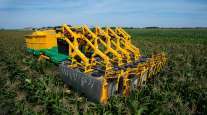Task Force to Study Autonomous Technology Underway in Oklahoma

Oklahoma state officials have held the first meeting of a task force that will study autonomous vehicles and how agencies and local governments should respond to the emerging technology.
Some vehicles already come with some level of autonomy, whether it’s braking or lane assist, but car developers are testing fully driverless vehicles in other parts of the country.
Eventually, Oklahoma may be home to cars and trucks that drive themselves.
“We know it’s not tomorrow, but it’s going to be within 30 years,” said Transportation Secretary Mike Patterson, who leads the task force.
The group plans to meet monthly and eventually will expand its membership and have bigger workshops, Patterson said. Now, the task force consists of representatives from the Oklahoma Department of Transportation, Oklahoma Department of Public Safety, universities, local governments and associations.
Oklahoma is one of only a handful of states studying the issue, and Patterson deliberately waited until now to convene so that automakers could settle more into what drivers may get to buy.
Safety is No. 1
Eric Pollard, clean cities manager with the Association of Central Oklahoma Governments, said the No. 1 issue is safety. The technology of automation will be incremental, but governments can do things now that will make things easier as there are more advances in the field.
“A lot of the investments that can be made to improve roadway safety for human drivers will also increase safety for the vehicles that have more autonomous capabilities,” he said.
Strict guidelines ultimately may be up to federal regulators, but there are things that state and local governments can do, including driver education and rules on where autonomous vehicles can operate.
Decision-makers still must also consider rural areas that have poor lighting, fewer vehicles to share the road and less infrastructure, Pollard said.
Department of Public Safety Commissioner Rusty Rhoades noted that the state’s response to autonomy isn’t unlike many other advances in technology. His goal is to protect people on the road if and when driverless cars come to Oklahoma, but also not hamper the industry’s development.
“As long as we can stay focused on the safety for both the drivers of those vehicles and the drivers of other vehicles, then I think we can come up with a plan that’s very workable,” he said.
Patterson said the first thing Oklahoma can, and should, do is look at connected semi-trailers hauling goods across the state. Trucking companies, including some based in Oklahoma, already have computer-assisted driving that allows the trucks to work in tandem on the roadway.
“We have companies in Oklahoma that want to use this technology,” he said. “They can when they leave the state, but they can’t when they get back home.”
Distributed by Tribune Content Agency, LLC




